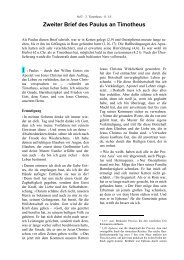You also want an ePaper? Increase the reach of your titles
YUMPU automatically turns print PDFs into web optimized ePapers that Google loves.
Neurons are the building blocks of the brain.<br />
They possess the same genes as other body cells,<br />
they are constructed along similar lines, and they<br />
are kept alive by the same biochemical processes<br />
which support other cells. But they differ in some<br />
essential aspects, making them the most extraordinary<br />
cells in a living organism. The differences<br />
include shape, type of cell membrane, and the<br />
presence of a structure known as a synapse. The<br />
cell membrane has the ability to produce neural<br />
signals, and in the synapses these signals are carried<br />
to other nerve cells by means of transfer<br />
substances called neurotransmitters.<br />
During the development of the organism from a<br />
fertilised ovum, neurons are formed at the astounding<br />
rate of 250,000 per minute over nine months.<br />
It used to be thought that neurons do not subdivide<br />
after an embryo is fully developed. Thus, the<br />
number of nerve cells formed up to the moment<br />
of birth had to last one’s entire lifetime. Recent<br />
evidence indicates that at least some nerve cells<br />
may be replaced in the adult organism after all.<br />
With between ten and fifty thousand connections<br />
per nerve cell, the entire system forms an<br />
immeasurably complex branched network. If it<br />
were possible to describe it as a circuit diagram,<br />
then even if each neuron were represented by<br />
a single pinhead, such a circuit diagram would<br />
require an area of several square kilometres!<br />
Compare this to the complex engineering drawings<br />
which are often produced according to<br />
the DIN-A0-Format on only one square metre<br />
(841 mm x 1189 mm). Such a circuit diagram of<br />
the brain would be several hundred times more<br />
complex than the entire global telephone network.<br />
In reality, nobody really knows anything<br />
much about the internal connections of the brain.<br />
The total length of the nerve fibres in the greater<br />
brain (cerebrum) is about 500,000 km, with some<br />
authors even estimating it to be as much as one<br />
million km. <strong>Our</strong> “command centre“, the brain,<br />
would be useless if there were no links to the<br />
body. Outside of the brain the total length of<br />
nerve fibres is 380,000 km, which is equal to the<br />
distance of the moon from the earth. They form<br />
a branching network throughout the body, continually<br />
carrying information and commands to<br />
82<br />
and fro between the brain and all our other parts.<br />
In places the thickness of these fibres is only one<br />
thousandth of a millimetre, but messages travel<br />
along them at a speed of about 40 metres per<br />
second or 144 km/h. This is equal to the speed of<br />
a hurricane-force wind (force 12).<br />
Processing speed: The incredibly dense neuronal<br />
network can process signals at a very high rate.<br />
The brain can do 10 18 = 1 million million million<br />
computations in a second, which is a hundred<br />
million times as fast as the fastest super computer<br />
at time of writing (10 10 calculations per<br />
second). The most fascinating aspect, however, is<br />
not the actual physical performance of the brain,<br />
but its ability to process these unimaginably vast<br />
quantities of information in unique ways which<br />
we cannot yet fully comprehend.<br />
Energy consumption: The brains of dogs and<br />
cats are responsible for between five and six per<br />
cent of the energy consumption of the entire<br />
animal. This is more or less true for all mammals<br />
(regardless of body size), with the exception of<br />
primates (apes, monkeys, etc.). In rhesus monkeys,<br />
the percentage is about nine, but for<br />
humans it is an impressive 20 per cent. <strong>Our</strong> brain<br />
requires about 20 Watts, which is one fifth of the<br />
energy (100 Watts) consumed by the whole body.<br />
The brain of a growing embryo requires a much<br />
greater proportion of energy, namely 60 per cent.<br />
Structure: The cerebrum occupies the greater<br />
part of the brain’s volume. It consists of two<br />
halves or hemispheres, each of which is responsible<br />
for the functioning of the opposite half of<br />
the body. The two halves are connected via the<br />
corpus callosum, which is essentially a broad<br />
cable made up of 300 million nerve fibres. Each<br />
hemisphere is covered by a three millimetre thick<br />
layer of nerve cells. This layer, the cerebral cortex,<br />
is intensely convoluted and has a total surface<br />
area of about 2,200 cm 2 . The cortex 1 enables us<br />
to organise, to remember, to understand, to com-<br />
1 Cortex: Latin cortex = bark, crust, shell. The word<br />
cortex is used anatomically to indicate the outer layer<br />
or surface of an organ. In the brain there is the cerebral<br />
cortex, and the cerebellar cortex; the kidneys<br />
have the renal cortex.
















